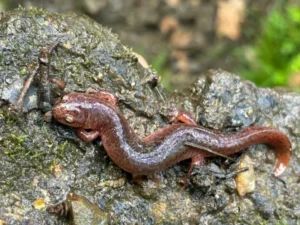Salamanders are quiet animals that spend their lives in damp forests, shallow streams, and still ponds. Some live on land, others live in water, and a few use both. No matter where they are found, one question often comes up: do salamanders need air?
Yes, all salamanders need air to survive. Even fully aquatic species need oxygen, whether they take it from the water or from the air above. But the way they breathe is not always what people expect.
Some salamanders have lungs, others have gills, and some breathe only through their skin.
The method depends on the species and how they live. Understanding these differences helps explain how salamanders survive in such a wide range of places.
How Salamanders Breathe Differently
Salamanders are amphibians. Like frogs and toads, they often begin life in water and later move to land.

But unlike mammals or fish, they do not all breathe the same way. Some have lungs, others have gills, and many rely on their skin.
Most animals use just one kind of breathing. Mammals, for example, breathe only through lungs. Fish use only gills.
Salamanders are different. They may use more than one method, and some species change how they breathe as they grow.
Three Main Breathing Methods
Salamanders breathe in three main ways:
- Through lungs
- Through gills
- Through their skin
Not every salamander uses all three. Some use only one method. Others switch methods depending on their age or environment.
Breathing Through Lungs
Some salamanders breathe with lungs. These lungs are simple and not as advanced as mammal lungs, but they get the job done. Salamanders with lungs must breathe air from the surface.
Tiger salamanders and fire salamanders are good examples. When they are young, they live in water and may use gills.
But as they grow up and move to land, they switch to lungs. Once they become adults, they depend on air to live.
These salamanders are often seen lifting their heads to take a breath.
They live in moist soil, leaf litter, or burrows, where they can easily reach the air around them.
Breathing Through Gills
Most baby salamanders start life with gills. Gills are soft, feathery structures on the sides of their heads that pull oxygen from the water.

Some salamanders keep these gills even after they grow up. Axolotls and mudpuppies are two well-known examples.
They live in water their whole lives and never develop lungs. Their gills stay with them and allow them to breathe underwater.
But even salamanders with gills still need oxygen. If the water gets too warm, too dirty, or too still, oxygen levels drop. In these cases, even aquatic salamanders may swim to the surface to gulp air.
If the problem continues, they can get sick or die. So while they do not leave the water, they still rely on oxygen just like any other animal.
Breathing Through Skin
Some salamanders do not have lungs or gills at all. These species rely fully on their skin to breathe. This is called cutaneous respiration, which means “skin breathing.”

To breathe this way, the skin must stay moist. Oxygen passes through the wet skin and into the blood. At the same time, carbon dioxide leaves the body through the same skin.
If the skin dries out, the salamander cannot breathe. That is why lungless salamanders live in shady, damp places like under logs, in mossy soil, or beside streams. Dry, sunny places are deadly for them.
Lungless salamanders belong to a large group that depends entirely on skin breathing. They are very sensitive to changes in temperature and humidity and cannot survive in dry or sealed places.
Do Water Salamanders Need Air?
Yes. Even salamanders that never leave the water still need oxygen. They may get it through gills, through their skin, or by coming to the surface to breathe.
Water does not always hold the same amount of oxygen. Heat, pollution, or stillness can reduce oxygen levels. When this happens, aquatic salamanders may become stressed or weak.
Some of them, like axolotls, may use both gills and lungs if needed. They do not need to live on land, but they still need air in some form.
A lack of oxygen in the water is one of the most common problems for salamanders in tanks or ponds.
Conclusion
Do salamanders need air?
Yes. All salamanders need oxygen to live. Whether they breathe through lungs, gills, or skin, they rely on fresh air or oxygen-rich water to stay alive.
Some salamanders come to the surface to breathe. Others pull oxygen through the water with gills.
Some rely completely on skin that must stay moist. But no matter the method, air is essential.
If you care for a salamander, make sure the air is fresh, the water is clean, and the tank is not sealed.
Keep humidity levels high for land species, and make sure the water is moving for aquatic ones.
Salamanders may be quiet and slow, but their breathing needs are complex. By understanding how they use air, we can care for them better and help protect them in the wild.
Hi, my name is Ezra Mushala, i have been interested animals all my life. I am the main author and editor here at snakeinformer.com.

